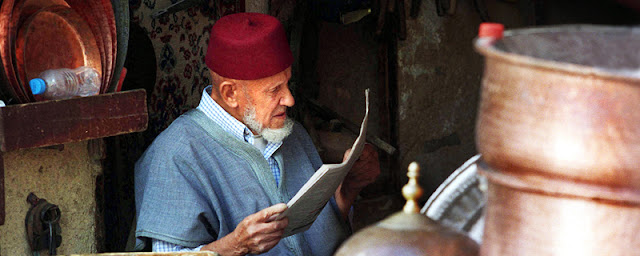Last night's diverse events closed the 8th annual Amazigh festival. Two concerts, one at the al-Hourriya Complex and one at Bab Makina, emphasised the sheer diversity of Morocco's roots and contemporary artistic expression. Chris Witulski reports.
The earlier event in the new city featured modern and traditional artists. The space was not overflowing, but the energy between the performers and audience was palpable. As Mohamed Akouray's small ensemble of Amazigh performers entertained the crowd, they highlighted the poetic tradition by reciting a long story in the "mother tongue" that was punctuated by applause and vocal responses from the listeners.
The four men, three dressed in white jellabas and one in more outrageous traditional garb, played
bendirs (frame drums) and a double-piped wind instrument not unlike many seen across North Africa. The wind player, marching around the stage, excited and engaged the audience - his connection was emphasised by the sheer volume of cameras that were taking pictures. It was stark, watching the traditional performance through the tiny screens of a sea of point-and-shoots.
The closer for the first concert was a
sh'abi singer, Abdou Ben Tayeb. His slick (and slightly shiny) suit was a vast jump from the traditional dress of the preceding artist. With two electric keyboards, a drum set, and an '
ud player, he got the audience moving and brought the event to a close.
A short taxi ride brought me to a very different concert that was just getting started at Bab Makina.
Sarsale, a young Catalonian flamenco group opened. As they began, their song choice demonstrated their chops and featured the singer, Ramón Piñas, and guitarist, Alberto Pons. Soon the crowd was treated to the dancing of Violeta Barrio before the tenor shifted to newer styles of flamenco-oriented songwriting.
 |
| Abd al-Rahim Amrani |
The first half closed with an appearance by Abd al-Rahim Amrani, the leader of a Fessi Hamadsha troupe. He joined the group to sing a popular song, creating a melodic connection between the international performers and the festival's local focus. (This was helpful, since flamenco's inclusion in the Amazigh festival was a bit tenuous at best in the first place, though not unwelcome!)
 |
| The caftan show |
Following a fashion show featuring Amazigh-styled caftans, the weekend's events concluded with a performance by Libyan rock group Oussan Band.
The lead singer walked out with a "Flying V" guitar, think Slayer, and I immediately expected some bone-jolting Amazigh death metal (which, to be honest, got me a bit excited). Instead, the band performed up pop-oriented tunes about Libya, Amazigh identity, and freedom, spiced with hints of reggae.
Alas, another summer festival comes to a close in Fez. Now, to see what Ramadan brings out way…
SHARE THIS!


























